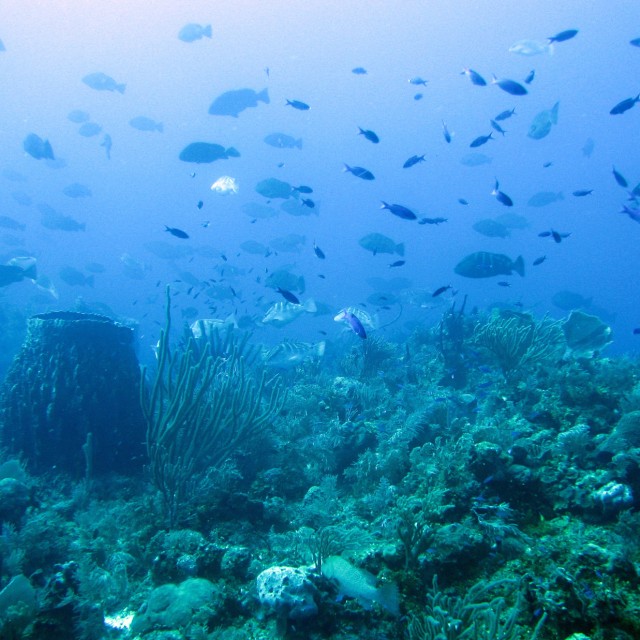Listening to Fish: How Sound May Help Us Identify and Study Life Underwater

Red Hind Grouper Hole. (Credit: Scripps Institution of Oceanography)
The sounds of animals are part of any child’s education; even studying a foreign language in school, you are likely to learn, for example, how a dog barks in your new tongue. Yet for the most part, we’re stumped when it comes to fish sounds. (I had a French textbook that told me fish said “glou glou” in that language, but since I now know “glou glou” is translated as “glug glug” or gurgling, the international language for drowning, I have my doubts.)
Now, however, a research team at the Marine Bioacoustics Lab at Scripps Institution of Oceanography led by oceanographer Ana Širović is working to listen for the sounds fish make. Ultimately listening for fish may allow scientists to identify species based on sound alone without disturbing them, making it easier to understand how and where to protect them.
“I have loved fish ever since I took my undergraduate course in fish biology,” details Širović. “When I moved on to do acoustic work for my graduate degree, I was always wondering how to get back to fish work, and investigating their sound production abilities was the obvious choice.”
Fish create sound either by rubbing their bones where their bodies and fins meet, or, more commonly, by oscillating the swim bladder. We have been familiar with the noises made by dolphins and whales for some time; why not fish sounds?
“Typically, fish sounds are much lower intensity, so they travel less distance and may be less noticeable,” Širović explains. “Of course, there are exceptions such as drums or croakers, which were named because of their prolific sound-making. But those are an exception, and unless people have been exposed to those loud species, generally, they are not aware of fish sound-making abilities.”
For two years now, Širović and her collaborators Jules Jaffe, Ed Parnell, graduate student Camille Pagniello, and post-doctoral scholar Jack Butler have been recording sound off La Jolla in kelp beds with funding from the California Sea Grant. The recordings were excellent, but they initially highlighted a problem: it wasn’t clear to the team which fish were creating which sounds. This is compounded by the fact that the nature of the sounds fish make depends on the situation and their intent; for example, they may be making spawning noises or defending territory.

Ana Širović. (Credit: Scripps Institution of Oceanography)
“The sound varies by species; some cases we know a fair amount about—mostly the very loud species—but for species that live in the kelp forests here off the west coast, we know very little to nothing,” remarks Širović.
Eventually the team aims to identify species based on sound alone, like bird enthusiasts identify species hearing a single call.
“That is our goal,” states Širović. “Lots of animal species produce species-specific sound, so the goal is to work our way to figuring out what they are for those fish species that are soniferous.”
Of course, working underwater makes perceiving and recording sound an even greater challenge than it would be otherwise. To meet this challenge, the team developed four underwater microphone and camera rigs to assist them in localizing sounds that they record and matching a face with a sound, so to speak.
“For acoustic recordings, we are using a 4-channel recorder called SoundTrap (built by Ocean Instruments, a New Zealand company), with hydrophones deployed in a tetrahedral configuration, and we couple the acoustic recordings with a Sony a7s ii camera with excellent low-light capabilities that is housed in an underwater housing,” details Širović. “The passive acoustic monitoring has been done by collecting long-term recordings. We have been using SM3M underwater recorders from Wildlife Acoustics, sampling continuously at 48 kHz. In that setup, the recorder can store data for a period of about a month, at which point we recover them, download the data, swap the batteries and redeploy. Then we used the acoustic-optical system in areas that we identified as having loud fish signals, to collect concurrent visual and acoustic data. By localizing the signals recorded on 4-channels of the recorder we can calculate the location where the signal is produced, and the ones that are co-located with the areas where we have camera images are used to identify possible sources of that sound.”
The researchers first tested the equipment in the Birch Aquarium’s kelp tank, which contains a known number of species. This allowed them to narrow down the species they heard, and identify what they were hearing more easily.
In the future, Širović and the team intend their work to help scientists generate a richer understanding of where and how fish breed and congregate, which in turn may allow policymakers to make data-driven decisions.
“For example, if we can identify which sound is produced by a spawning fish, then we could also identify timing and locations of fish spawning aggregations by recording sounds,” Širović explains. “The information on where and when fish spawn could then be used to enact protective measures if policy makers decided that was important.”
A robust grasp on fish noises will also allow scientists to engage in a less invasive form of monitoring fish behavior.
“That is definitely one of the interests and goals,” remarks Širović. “This would be a non-lethal and minimally disruptive way to allow long-term monitoring.”
And while the “glou glou” mystery remains unsolved for now, it seems highly likely that we’ll be hearing more of the real sounds fish make in the near future. To hear some now, view the team’s audio captures here.





0 comments